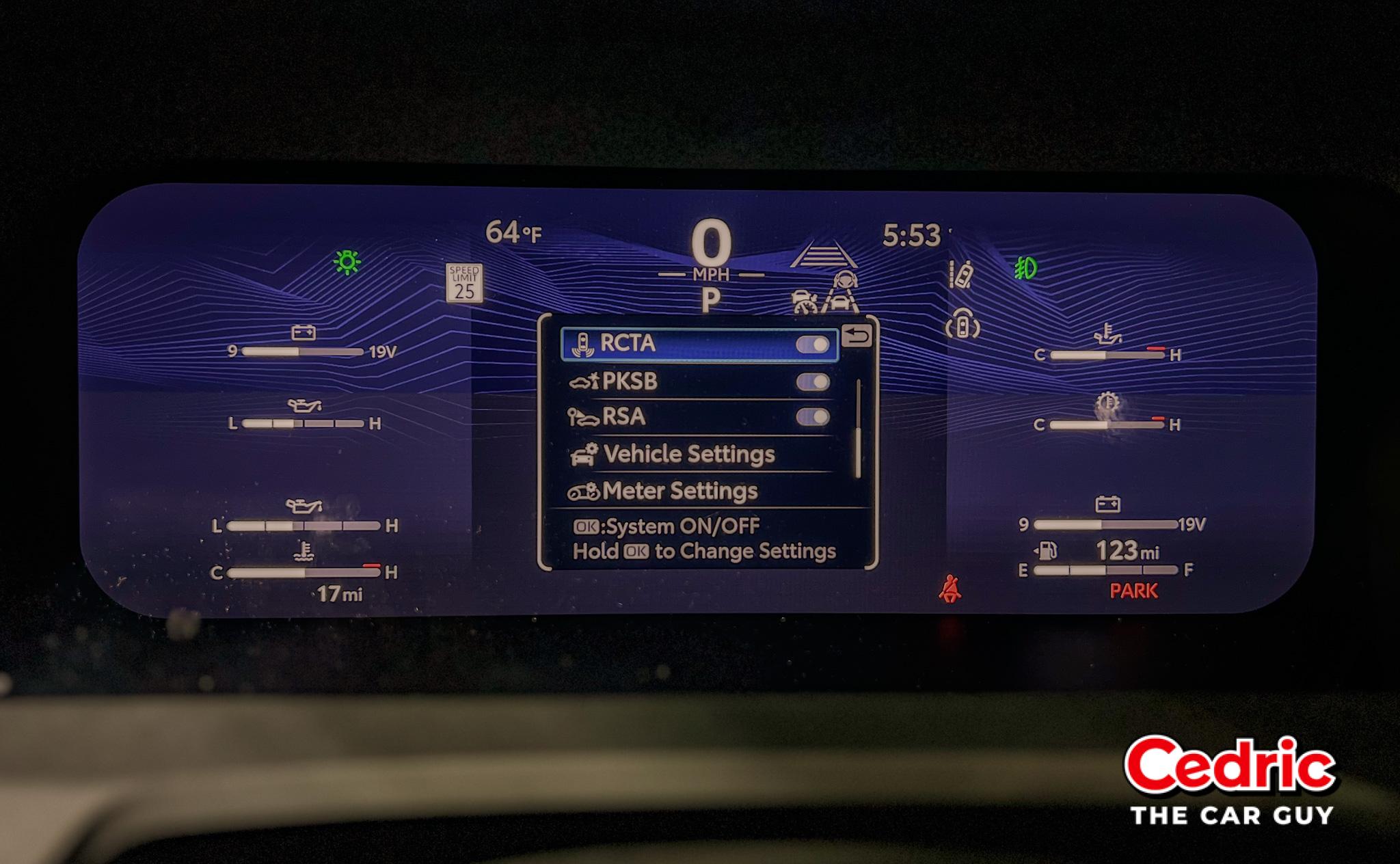Toyota RCTA | Rear Cross Traffic Alert

Toyota RCTA (Rear Cross-Traffic Alert) kicks in when backing up, using Toyota BSM’s radar to warn of cross-traffic behind you with an audio and visual alert.
So whether you’re backing out of your driveway or maneuvering through a crowded parking lot, knowing what’s happening around your vehicle can make all the difference. That’s where features like Toyota BSM (Blind Spot Monitors) and Rear Cross-Traffic Alert (RCTA) come into play, seamlessly integrated into many Toyota models alongside renowned safety suites like Star Safety System™ and Toyota Safety Sense 3.0.
Table of Contents
Overview of Toyota Rear Cross-Traffic Alert (RTCA)
Let’s zoom in on the Rear Cross-Traffic Alert (RCTA). This smart safety feature provides an added layer of awareness for drivers. RCTA is particularly handy when visibility might be limited, such as when backing out of a parking spot or driveway.
So, how does it work? Well, imagine you’re at a busy shopping center, and it’s time to leave. You’re parked between two large SUVs, and your view is obstructed. As you slowly reverse, Toyota RCTA springs into action, scanning for approaching vehicles from the side. If it detects any oncoming traffic – whether it’s a car zooming down the aisle or a pedestrian crossing behind you – RCTA sends out an audible and visual alert to warn you of the potential hazard.
This real-time warning gives you precious seconds to react, helping to prevent fender benders and near misses. It’s like having a trusted co-pilot watching your back, ready to intervene when needed.
But RCTA doesn’t rely on sensors alone. It’s backed by advanced technology that considers factors like vehicle speed and trajectory, ensuring that the alerts are accurate and timely. Plus, with the convenience of customizable settings, you can tailor RCTA to suit your driving preferences and surroundings.
*Pro-tip: RCTA can even apply the brakes and stop the vehicle in an attempt to avoid a rear collision.

How to Activate Toyota RCTA
> 1. Start by turning on your vehicle’s ignition and ensuring that the vehicle is in Park.
> 2. Locate the Multi-Informational Display (MID), which is generally located between the Speedometer and Tachometer on the vehicle’s dashboard.
> 3. Depending on your model, the RCTA settings may be accessed through the main menu or the vehicle settings submenu.
> 4. Look for the gear-wheel icon on the MID and navigate to the “Settings” or “Vehicle Settings” menu.
> 5. Scroll through the safety features menu until you find the “Rear Cross-Traffic Alert” or “RCTA” option. Select it to enter the RCTA settings.
> 6. Within the RCTA settings, you may find options to enable or disable the feature, adjust the sensitivity of the alerts, or customize the alert types (audible, visual, or both).
> 7. Toggle the switch or select the appropriate option to activate Rear Cross-Traffic Alert. If prompted, confirm your selection to save the changes.
> 8. Exit the settings menu and return to the main display or home screen.
> 9. Rear Cross-Traffic Alert is now active and ready to assist you during your drives. Remember to keep an eye out for any audible or visual alerts while reversing, indicating the presence of oncoming traffic or obstacles.
Disclaimer: Some Toyota vehicles have a physical button to enable RCTA on or off. If so, it will be located on the left side of the dash or under the air conditioning controls of some trucks and SUVs.

Key Features of Toyota RCTA
1. Enhanced Safety: RCTA provides an additional layer of safety by alerting drivers to approaching vehicles or pedestrians while reversing, especially in situations with limited visibility.
2. Real-Time Alerts: RCTA utilizes advanced sensors and technology to deliver timely audible and visual alerts to warn drivers of potential hazards behind the vehicle.
3. Customizable Settings: Drivers can tailor RCTA settings to suit their preferences and driving environment, including adjusting the sensitivity of alerts and choosing between audible, visual, or both types of warnings.
4. Intelligent Detection: RCTA takes into account factors such as vehicle speed and trajectory to accurately detect and alert drivers to oncoming traffic or obstacles.
5. Seamless Integration: Integrated seamlessly into the vehicle’s existing safety system, RCTA works in conjunction with other features like Blind Spot Monitor (BSM) to provide comprehensive coverage and awareness around the vehicle.
6. Added confidence: With RCTA activated, drivers can maneuver confidently in challenging situations, knowing they have an extra set of eyes, helping to prevent collisions and accidents while reversing.
Toyota Safety Sense 3.0
Now standard across the lineup are Blind Spot Monitors (BSM) with Rear Cross-Traffic Alert (RCTA) for a safer, more convenient driving experience. New Traffic Jam Assist (TJA) facilitates stop-and-go driving on congested roads by controlling acceleration, braking, and steering within a speed range of 0 to 25 mph. Toyota Safety Sense (TSS) is an advanced suite of safety features designed to keep drivers and passengers safer on the road. These innovative technologies help avoid accidents altogether. Here is a list of components within the suite:
- Pre-Collision System (PCS): Detects vehicles, pedestrians, cyclists, and motorcyclists, providing warnings and emergency braking if needed.
- Lane Departure Alert (LDA): Warns drivers of unintentional lane departure and may provide corrective steering.
- Dynamic Radar Cruise Control (DRCC): Maintains a set distance from the vehicle ahead, adjusting speed accordingly.
- Lane Tracing Assist (LTA): Keeps the vehicle centered in its lane using lane markers and preceding vehicles.
- Automatic High Beams (AHB): Automatically switches between high and low beams based on surrounding traffic.
- Road Sign Assist (RSA): Detects and displays road signs to enhance driver awareness.
- Proactive Driving Assist (PDA): Provides braking or steering support to maintain distance and stay in lane.
Recap of Toyota RCTA
In conclusion, Rear Cross-Traffic Alert (RCTA) offers drivers invaluable peace of mind by providing timely warnings of approaching vehicles or pedestrians while reversing. With customizable settings and intelligent detection technology, RCTA seamlessly integrates into Toyota vehicles, enhancing safety and confidence on the road. By activating Toyota RCTA, drivers can easily navigate challenging situations, knowing they have an extra layer of protection against potential collisions.
Frequently Asked Questions
RCTA is a safety feature in many Toyota vehicles that alerts drivers to approaching vehicles or pedestrians while reversing, especially in situations with limited visibility.
RCTA utilizes sensors and advanced technology to detect vehicles or pedestrians approaching from the side while the vehicle is in reverse. It then provides audible and visual alerts to warn the driver of potential hazards.
RCTA activates when the vehicle is in reverse and detects potential cross-traffic approaching from either side, typically in parking lots, driveways, or other areas with obstructed visibility.
Yes, RCTA settings can usually be customized to suit your preferences and driving environment. You can adjust the sensitivity of the alerts and choose between audible, visual, or both types of warnings.
While RCTA is designed to assist drivers in various conditions, factors such as extreme weather, obstructions, and sensor limitations may affect its performance. It’s essential to remain vigilant and use RCTA as an aid, not a substitute for careful driving.
RCTA may be available as an optional or standard feature on select Toyota models. Check with your local Toyota dealership or refer to your vehicle’s specifications to confirm its availability.
While RCTA enhances driver awareness and safety, it cannot prevent all accidents while reversing. Drivers must always exercise caution, check their surroundings manually, and use RCTA as a supplemental aid to safe driving practices.
Note: Always refer to the vehicle’s Owner’s Manual for more detailed information about your specific vehicle. Safe driving practices should always be followed. For more details, contact your local Toyota Dealer or visit Toyota.com.

Cedric Jackson
Cedric is a Sales Pro with 20+ years of experience. He is currently a Sales Consultant at Toyota of Riverside. He aims to share his passion for product knowledge of the Toyota brand here on his blog. Cedric writes content here and produces short-form videos on YouTube, Instagram & TicTok. Connect with him here or on all social media @ cedricthecarguy 🙏🏾🤙🏾

Cedric Jackson
Cedric is a Sales Pro with 20+ years of experience. He is currently a Sales Consultant at Toyota of Riverside. He aims to share his passion for product knowledge of the Toyota brand here on his blog. Cedric writes content here and produces short-form videos on YouTube, Instagram & TicTok. Connect with him here or on all social media @ cedricthecarguy 🙏🏾🤙🏾

